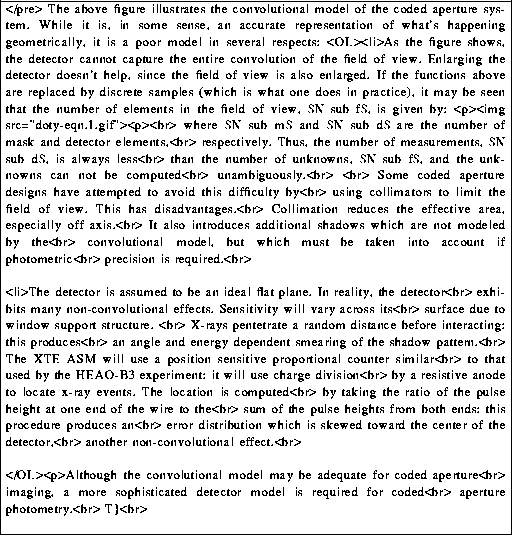
The general history of coded aperture cameras is covered well in a recent review paper. This section will describe the process by which the XTE ASM was invented and configured.
In 1976, George Ricker circulated a preprint, A Diffraction-Limited X-ray Shadow Camera. This paper was unique in its emphasis on the photometric and astrometric properties of the coded aperture approach, rather than on its imaging properties. He advocated the use of one-dimensional systems, and even anticipated Fenimore and Cannon's URA concept by advocating ``pseudorandom shift register sequences'' as mask patterns (although he did not pursue this idea in detail). This paper was never published, but it had a seminal effect at MIT.
The next two years saw important developments in coded aperture imaging from the Birmingham and Los Alamos groups. Although the the design of the aperture mask was the stated subject of both these papers, the wider issues of overall imaging camera architecture were discussed. These papers made it clear to me that unambiguous imaging with these systems required not only a good mask design, but an architecture which limits the field of view, so that the number of unknowns in the image is smaller than or equal to the number of measurements (see box).
But why shouldn't the deconvolution be straightforward without special tricks? After all, deconvolution using Fourier transforms is straightforward and well behaved as long as the convolving function has no zeros in its power spectrum. The reason that the coded aperture system's deconvolution is tricky comes from the fact that while Fourier deconvolution works on cyclic functions, the image captured by the coded aperture camera is not cyclic.
But it could be! I had the idea that one might scan a one-dimensional shadow camera in its imaging direction. The shadows on the detector would move, of course, until you had scanned 360°, at which point the original shadow pattern would be restored. Thus, the sequence of shadowgrams would form a cycle, whose pattern would be the intensity of the sky along the scan cyclically convolved with the mask pattern. This is the "scanning shadow camera" (SSC) architecture.
For those interested in two dimensional imaging, I note that this idea does not work in two dimensions. The reason is topological: the 2D Fourier transform has toroidal topology, unlike the spherical topology of the sky.
These ideas were still in my mind when, in 1980, we began work on the MIT XTE proposal. It was clear to us that some sort of ``all sky monitor'' was very important to the XTE mission. We had used slat collimators as sky monitors on SAS-3, and so I initially looked at the possibility of using them on XTE. The difficulty with slats is that it is hard to make an efficient collimator with a width of <1°, yet 1° is not enough resolution to dissect the dense concentration of sources in the galactic bulge. I therefore thought of using the high resolution of the one-dimensional shadow camera to help with this region. My original idea was to combine a single SSC with a pair of collimated detectors.
I discussed this idea with Garrett Jernigan, and, after he had thought about it, he came back to me with a a different idea: eliminate the slats and use two slightly tilted one-dimensional shadow cameras. He had calculated that the shadow camera was not only better at resolving sources, but better at measuring their intensities as well. The reason is that a narrow scanning slat collimated detector is ``photon starved'': its signal to noise ratio is, for many objects of interest, dominated by the statistics of the source photons themselves. The shadow camera captures more photons, and therefore exhibits a better signal to noise ratio.
